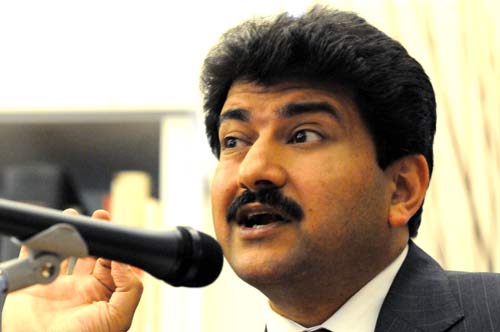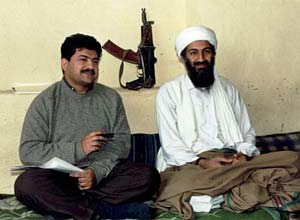 Hamid Mir (Peg Skorpinski photo)
Hamid Mir (Peg Skorpinski photo)Veteran journalist says schools and hospitals, not missile attacks, can defeat al Qaeda
Pakistani Hamid Mir, who interviewed Osama bin Laden three times, calls on the West to bring development to his country's border with Afghanistan
| 09 April 2009
BERKELEY — The first time Hamid Mir interviewed Osama bin Laden, in 1997, the militant Islamist was so little-known that Mir's editor wondered why he had bothered. The third time — soon after the 9/11 attacks on New York and Washington — American bombs were raining down upon the compound in Kandahar, Afghanistan, where the newly notorious al Qaeda leader had gone into hiding. Mir thought he would never get home alive.
 Hamid Mir with Osama bin Laden during one of three meetings with the terrorist mastermind since 1997.
Hamid Mir with Osama bin Laden during one of three meetings with the terrorist mastermind since 1997."The terror was on my face," Mir recalled last week in an appearance sponsored by the campus Center for South Asia Studies. Bin Laden, meanwhile, casually munched on olives and bread and drank tea in his cave, and "was just laughing and making fun of me."
The veteran Pakistani journalist, who's been courting danger in the lawless tribal areas on the Pakistan-Afghanistan border for more than 20 years, is now putting the finishing touches on a book about bin Laden. During his talk in the North Gate Library, though, he focused less on his close encounters with high-profile terrorists than on how to quell the resurgence of al Qaeda and the Taliban — both of which, he said, were midwifed with America's help after the Soviet invasion of Afghanistan in 1979.
"One day they became a monster," Mir declared. "And today I am here to speak about the monster."
Mir, speaking Urdu-inflected English and wearing a natty, Western-style suit — an outfit that, in the tribal areas, would be "considered the dress of the anti-Islam forces" — referred repeatedly to a map of the border region between Pakistan and Afghanistan, typically described as a "safe haven" for al Qaeda.
Pointing to frequent terrorist attacks in the area — including the recent suicide-bombing of a mosque — he insisted that such a characterization misses the mark. Of the 58 worshipers killed in that bombing, he noted, 10 were members of the Pakistani security forces, and two were intelligence officials.
"If this area is the safe haven of al Qaeda, then why is al Qaeda hitting this 'safe haven' again and again?" he wondered. The mosque killings, he said, put the lie not only to the notion that terrorist forces have firm control of the region, but to the idea that their motivation is primarily religious.
"Any person who can attack a mosque, any person who can attack about 58 people in one go — and those people were offering prayer in a mosque — how can you say they were Muslims?" demanded Mir. "It's not an attack on a mosque, it's an attack on Islam."
Yet just as America and the West were complicit in the 1977 toppling of his country's first elected president, Zulfikar Ali Bhutto — father of assassinated Pakistani leader Benazir Bhutto (and a 1950 Berkeley alum) — Mir insisted that U.S.-directed drone attacks on the tribal areas are killing many more civilians than terrorists, and are turning even mainstream, well-educated Pakistanis against the United States.
As an example, he cited a recent interview he'd conducted for Pakistan's popular Geo TV, where he now serves as Islamabad bureau chief, with Shehzad Roy, a "very famous pop singer" whose new album is "full of anti-U.S. songs."
Civilian deaths attributed to American drone attacks, insisted Mir, are contributing to "a process of radicalization — radicalization of not only the people of this tribal area, [but] the radicalization of Pakistani pop singers."
"We realize — Pakistan, America, the whole international community — everybody wants to defeat al Qaeda and the Taliban." But "blunders" in our treatment of the tribal areas, added Mir, "are only strengthening their hands."
'This is very simple'
Mir grew emotional in recalling his travels through the border region, noting that media workers "have paid a very high price for covering the conflict in this area" — including death at the hands of the Taliban, the Pakistan army, or intelligence forces. Only a handful of journalists are still willing to operate there, he said, most too fearful of retribution to use bylines in their reporting.
"I am able to share this information with you due to the sacrifices of some of my cameramen, some of my guides, and some of my colleagues who are no more with me today," he said.
Yet Mir, pointing to the red-colored tribal areas on his map — a poorly monitored, 1,300-mile stretch of mountainous landscape where only journalists are required to produce visas to cross the border — repeatedly returned to his main theme: This region, which holds barely 2 percent of Pakistan's 170 million people, is "one of the most underdeveloped areas, not in Pakistan, not in South Asia, but in the world." And the key to defeating al Qaeda and the Taliban is to bring it some of the benefits enjoyed by the rest of Pakistan — roads, schools, hospitals, and rule of law.
"If an 18-year-old boy wants employment in that area, he'll go to the Taliban. And if an 80-year-old elderly person wants some justice, he will also go to the Taliban. Because there is no government," Mir said.
It wasn't until 2003, in fact — after more than a half-century of official neglect — that the government established any presence at all in the area. At that time, said Mir, "the tribal elders showered rosebuds on the Pakistani army," so grateful were they for its promises of development.
"Then [George W.] Bush started calling [then-President Pervez] Musharraf," recounted Mir. "He said, 'Congratulations, your army has entered the Pakistani tribal areas. When are you going to start your military operations?' And Mr. Musharraf never explained that 'I ordered my army to enter the tribal areas to do some development work.'
"Lots of innocent civilians were killed" in the subsequent, U.S.-backed anti-terror attacks, said Mir. "And that's how the tribals turned against the Pakistani army. That's how the tribals turned against the United States of America."
The way to win them back, argued Mir — and to dry up support for Islamic extremists operating in their midst — is to halt drone attacks in tribal areas, beef up border checkpoints, increase regional cooperation, and — above all — provide real economic and educational opportunities for local populations.
"If U.S. drones are killing innocent civilians in that area, they will hate you," said Mir. "But if you are ready to give them schools and hospitals, they will love you. This is very simple."
"It is not impossible to defeat al Qaeda and the Taliban," he declared. That can only be achieved, however, "by spreading more knowledge, by spreading more light — and light is education."
Even so, his appearance left little doubt that along Pakistan's western border, at least — as illustrated by Mir's last, harrowing meeting with Osama bin Laden — the search for knowledge can be a life-and-death proposition.

